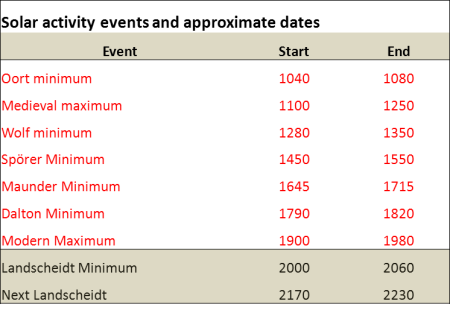A recent post by John O’Sullivan reminded me that it is time for the next solar minimum that is on its way to be named after the man who predicted it. Theodor Landscheidt (born in 1927 in Bremen, Germany, died on May 20, 2004) was an author and amateur climatologist. In 1989, Landscheidt forecast a period of sunspot minima after 1990, accompanied by increased cold, with a stronger minimum and more intense cold which should peak in 2030 which he described as the “Landscheidt Minimum”.
The sun goes through its cycles as it will and at its own pace and we continue to struggle to try and decipher the various cycles that exist, what causes them and what effects they have on the earth. Some of the cycles known or hypothesised to exist are the:
- 11 year sunspot cycle
- 22 year magnetic cycle
- 87 year Gleissberg cycle
- 166 year “unnamed” cycle
- 210 years Suess or de Vries cycle
- 2,300 years Hallstat cycle
- 6000 years Xapsos and Burke cycle
Landscheidt’s paper is here: New Little Ice Age instead of Global Warming?
Abstract: Analysis of the sun’s varying activity in the last two millennia indicates that contrary to the IPCC’s speculation about man-made global warming as high as 5.8°C within the next hundred years, a long period of cool climate with its coldest phase around 2030 is to be expected. It is shown that minima in the 80 to 90-year Gleissberg cycle of solar activity, coinciding with periods of cool climate on Earth, are consistently linked to an 83-year cycle in the change of the rotary force driving the sun’s oscillatory motion about the centre of mass of the solar system. As the future course of this cycle and its amplitudes can be computed, it can be seen that the Gleissberg minimum around 2030 and another one around 2200 will be of the Maunder minimum type accompanied by severe cooling on Earth.
The indications are that we are approaching a solar minmum just as Landscheidt predicted and the question is now whether this will be similar to a Dalton Minimum (1790 – 1820) or as severe as a Maunder minimum (1645 – 1715). As I have posted earlier:
It took 500 years with reducing solar activity to get from the Medieval maximum to the the grand Maunder minimum. The Dalton minimum came a little over a 100 years later as solar activity was increasing to its modern maximum in the years preceding Solar Cycle 22 (c. 1890 – 1990). Now with the Landscheidt minimum seemingly well established, SC 23 and the current SC 24 show a clear trend of declining solar activity. SC’s 22, 23 and 24 are remarkably similar to SC’s 3, 4 and 5. The Dalton minimum coincided with SC’s 5 and 6.
It is reasonable to assume that climatic conditions over the next 20 – 30 years will resemble those prevailing between 1790 and 1820. But SC24 has a way to go yet and it could be that solar activity for SC24 and 25 will be even lower than during the Dalton minimum and perhaps closer to the Spörer minimum but perhaps not as deep as the Maunder minimum.

Solar activity events recorded in radiocarbon. Present period is on left. Values since 1900 not shown. (Wikipedia)

Recent solar activity (Wikipedia) showing the Maunder and Dalton minima
Landscheidt also predicted that after the next solar minimum in 2030 the following minimum would occur in 2200.
It is perhaps time to officially name this minimum that is coming as the “Landscheidt Minimum”.
Tags: Dalton minimum, Landscheidt Minimum, Little Ice Age, Maunder Minimum, solar cycle, Solar variation, Theodor Landscheidt
